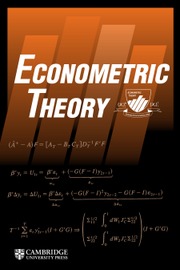No CrossRef data available.
Article contents
INFERENCE IN MEDIAN AR MODELS WITH NONSTATIONARY AND HEAVY-TAILED HETEROSKEDASTIC NOISES
Published online by Cambridge University Press: 07 July 2025
Abstract
This article studies estimation and inference in the autoregressive (AR) models with unspecified and heavy-tailed heteroskedastic noises. A piece-wise locally stationary structure of the noise is constructed to capture various forms of heterogeneity, without imposing any restrictions on the tail index. The new nonstationary AR model allows for not only time-varying conditional features but also unconditional variance and tail index. This makes it appealing in practice, with wide applications in economics and finance. To obtain a feasible inference, we investigate the self-weighted least absolute deviation estimator and derive its asymptotic normality. Since the asymptotic variance relies on an unobserved density, a bootstrap method is proposed to approximate the limiting distribution. Based on the conditional moment condition, a portmanteau test from residuals is further proposed to detect misspecifications in the proposed model. A simulation study and two applications to time series illustrate our inference procedures.
Information
- Type
- ARTICLES
- Information
- Copyright
- © The Author(s), 2025. Published by Cambridge University Press
Footnotes
I would like to extend sincere thanks to the Editor, Prof. Peter C.B. Phillips, the Co-Editor, Prof. Yixiao Sun, and two anonymous referees for their critical comments and thoughtful suggestions. Special thanks go to Prof. Yixiao Sun for his invaluable assistance and support, which have significantly contributed to the improvement of this article. I also appreciate Prof. Shiqing Ling and Dr. Ke Zhu for their valuable discussion. This research was supported by the Natural Science Foundation of China (Grant No. 12201510).

